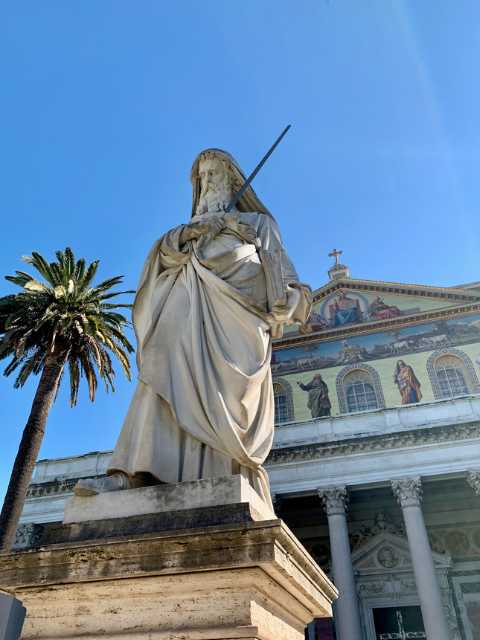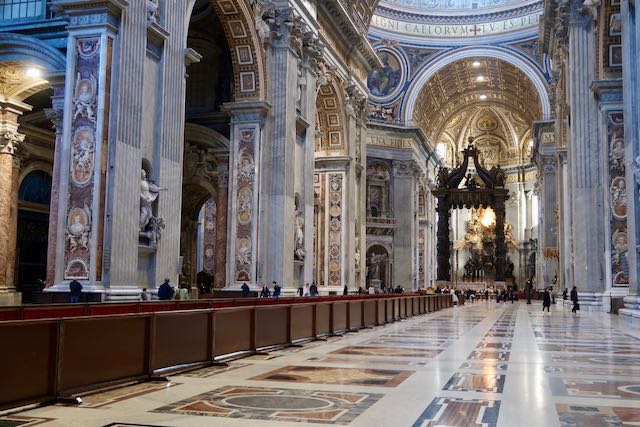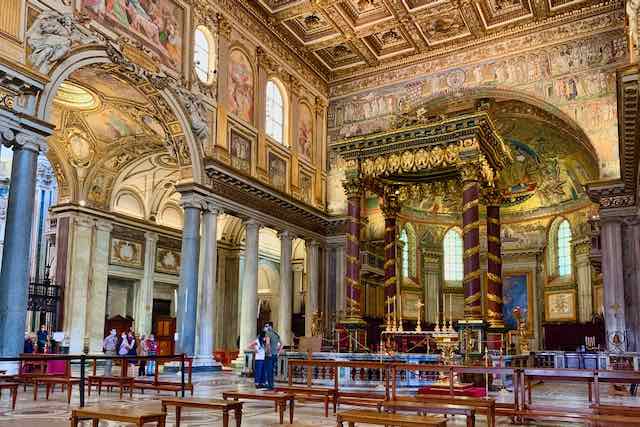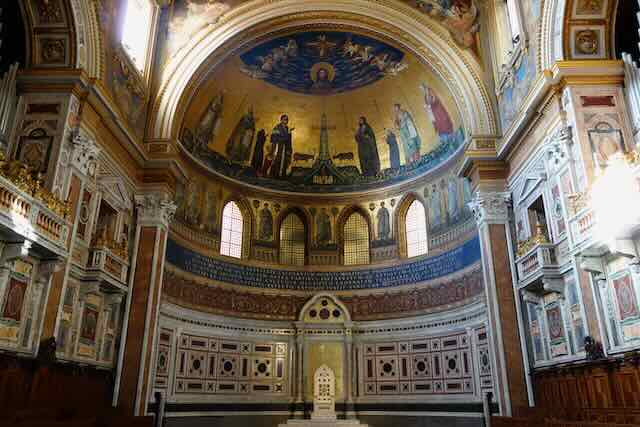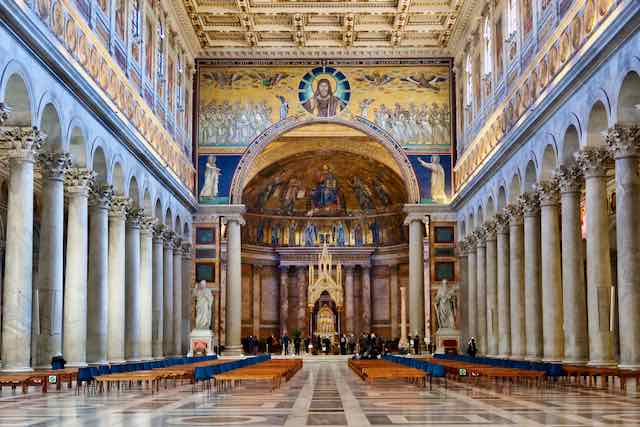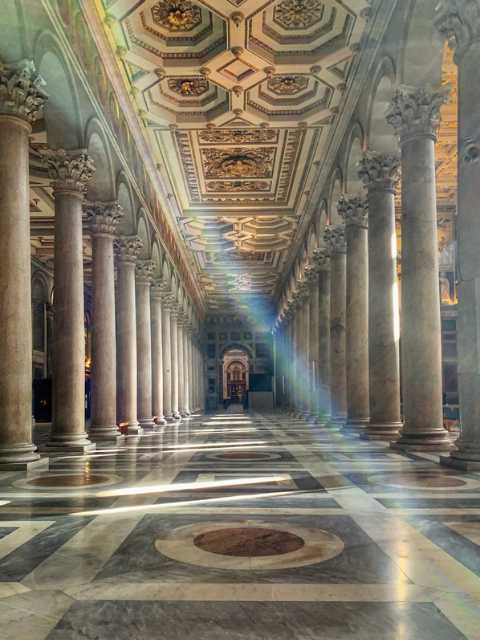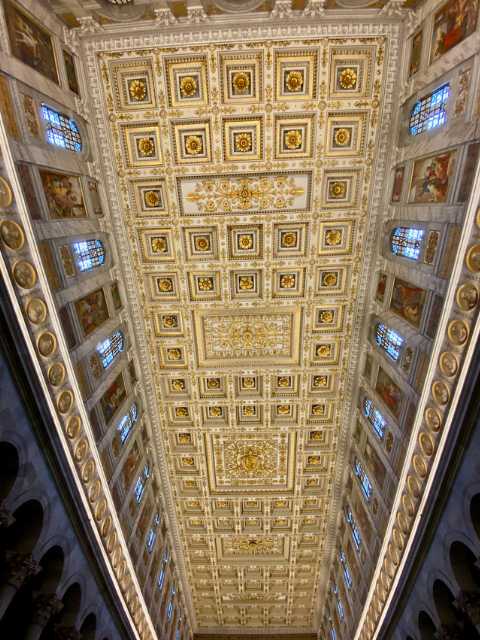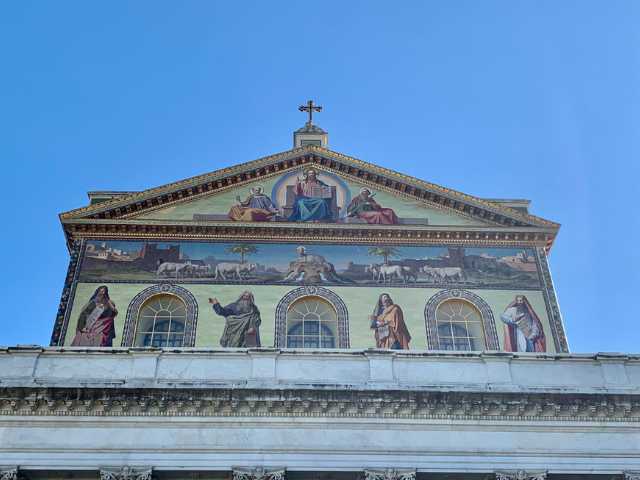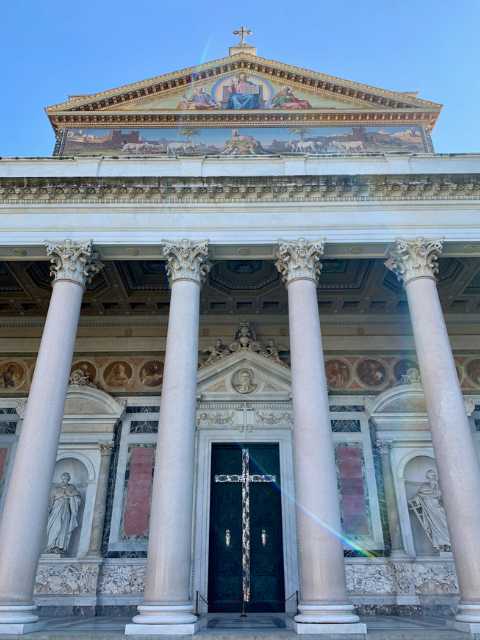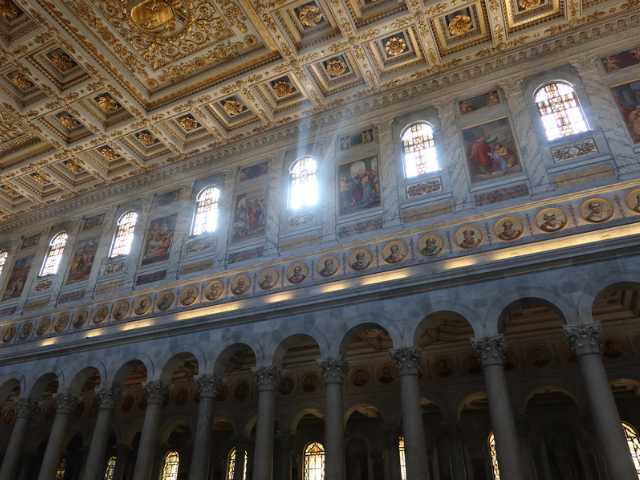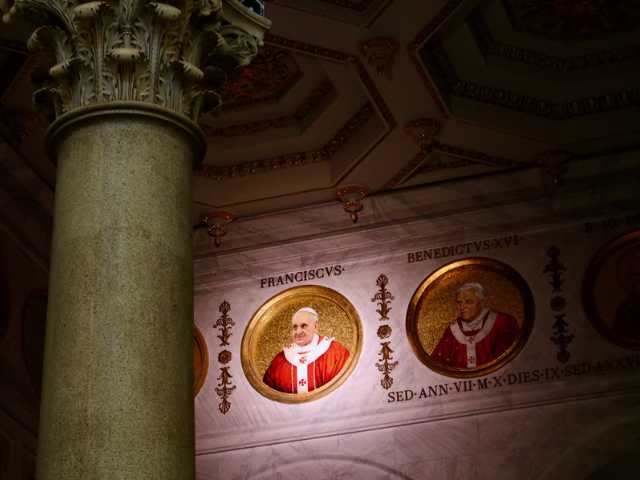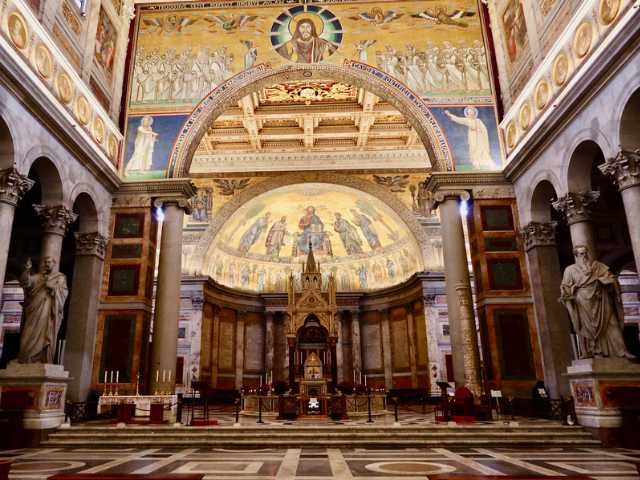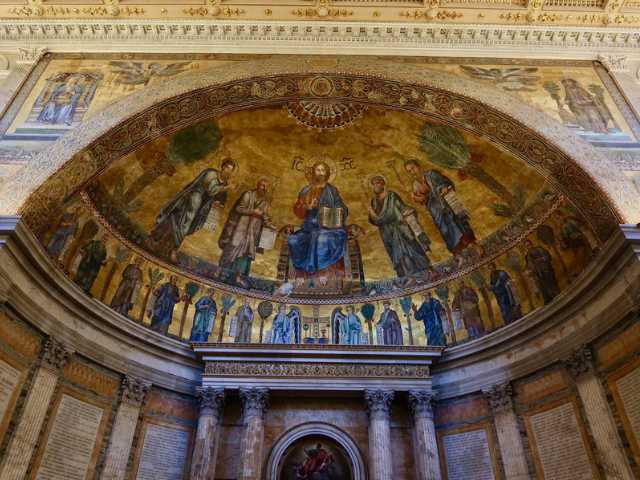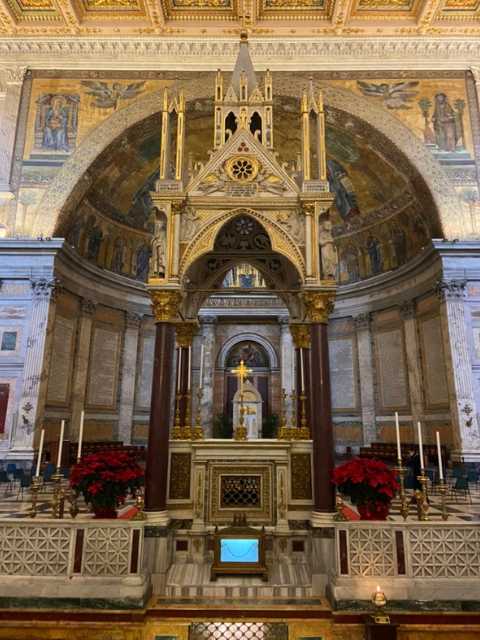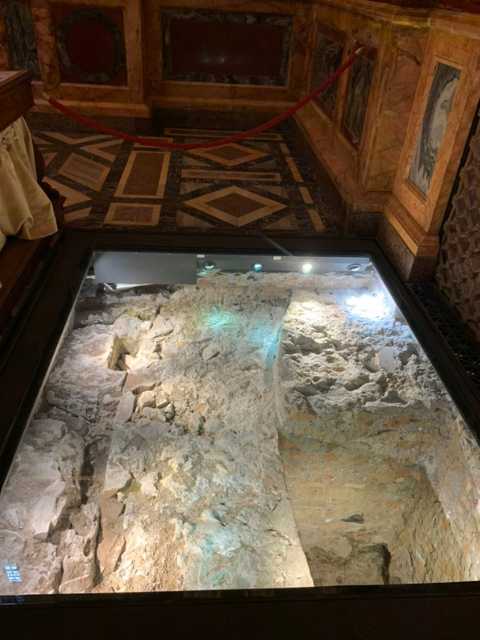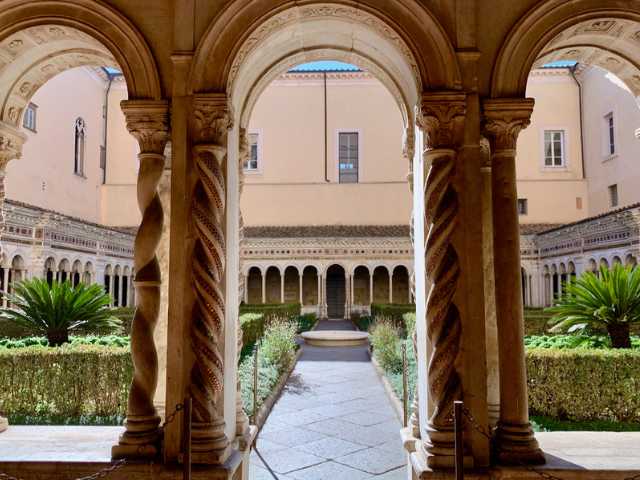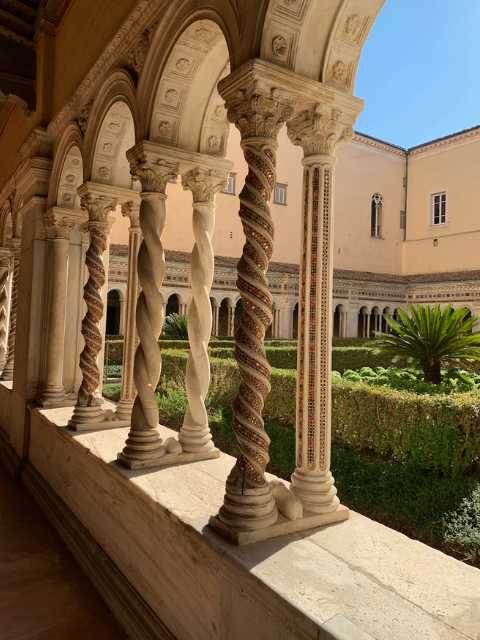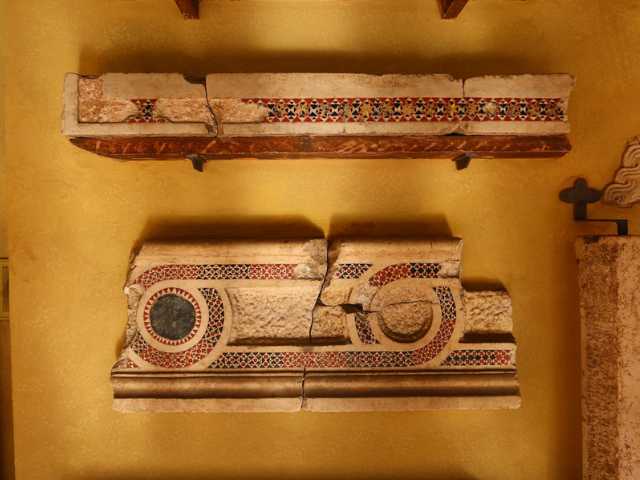- Sign up & get a FREE ebook Subscribe NOW!
- Romewise Home Page
- What to Do in Rome
- saint paul outside the walls
Papal Basilica of Saint Paul Outside the Walls
Wondering if you should visit Saint Paul Outside the Walls in Rome?
It is Rome's second largest church and this Papal basilica, one of only 4 Papal basilicas in the world, will knock your socks off!
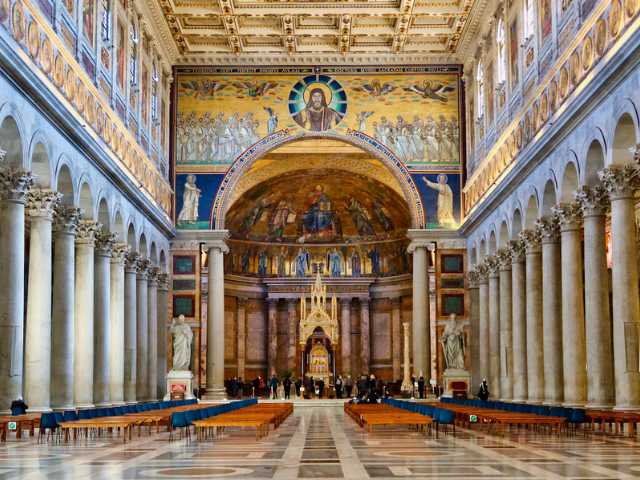 The basilica of Saint Paul Outside the Walls is a little way out of the city center but so worth a visit!
The basilica of Saint Paul Outside the Walls is a little way out of the city center but so worth a visit!The glittering mosaics, the stunning apse, the massive, awe-inspiring structure of the beautiful basilica itself, and of course, the burial place of the Apostle Paul all make this a must-see in the Eternal City!
St Paul Outside the Walls Basilica in Rome - Everything you need to know
You may not have heard of this basilica and may wonder why I called it a must-see.
It's not usually on most top-ten lists of things to see in Rome, and it is not easy to fit it into a typical 3-day Rome itinerary.
But if you have an interest in Catholicism, in ancient Rome, in archeology, art or architecture, you should definitely put this beautiful site on your list!
Here's everything you need to know about the Papal basilica (basilica papale) of St. Paul Outside the Walls, or Basilica di San Paolo Fuori le Mura in Italian:
- Why is the basilica of St Paul Outside the Walls significant?
- What happened to St Paul in Rome?
- Is St Paul's tomb in the Vatican?
- What is the history of Saint Paul Outside the Walls Basilica?
- What is there to see in St Paul Outside the Walls Basilica?
- Opening hours, location and how to get there
Why is the Basilica of Saint Paul Outside the Walls significant?
The importance of this papal basilica in Rome is because of its association with St Paul.
The History of the Apostle Paul
The Basilica of St Paul traditionally is held to contain the remains of the apostle Paul, otherwise known as Saint Paul (San Paolo in Italian).
He is considered among the most important figures of first-century Christianity.
Previously known as Saul of Tarsus, he famously underwent a conversion to Christianity while on the road to Damascus, in which Christ himself addressed him.
For those who follow the Christian faith, St Paul is one of the most important figures in the Christian world.
14 of the 27 books in the New Testament are attributed to Saint Paul's writing and his teachings are very much at the core of today's Christian religions.
Saint Paul's life and work are detailed in the Book of Acts.
St Paul's final resting place
In recent years a sarcophagus that lies under the main altar was examined, and the bones within were subject to radiocarbon dating.
This proved that they date to the first or second century, reinforcing the belief these are the remains and burial place of St Paul, one of the twelve apostles.
Basilica di San Paolo fuori le mura/ Saint Paul Outside the Walls Basilica building
Today the Basilica, which has undergone plenty of restoration at various times throughout history, is an important pilgrimage site for Catholics and a national monument.
It is one of the most significant churches in Rome.
However, a lot has changed architecturally from the first basilica on this site to the church that stands there today.
The four major (papal) basilicas
What happened to St Paul in Rome?
Paul's teachings involved bringing gentiles (non-Jewish persons) into the faith, which angered many of the Jewish elders.
Having already been arrested in Jerusalem on these grounds, he arrived in Rome shortly after and was immediately put under house arrest.
According to writings of the time, Paul continued to preach from his home while awaiting trial.
There are conflicting reports about Paul's death, although many biblical scholars have written that he was beheaded, some say at the same time as Saint Peter, and thus martyred by his captors.
Why did St Paul go to Rome?
The apostle Paul travelled to Rome to stand trial, as he wished to protest his innocence and further spread the word of Christ.
The journey to Rome by sea was not without incident, as Paul was shipwrecked on what we now know as Malta, where locals are said to have treated him with kindness.
When was St Paul in Rome?
It is believed that Paul arrived in Rome in 60 CE.
He is said to have spent two years under house arrest in the city until his trial.
The exact date of Paul's death is unknown, but it can be placed between July 64 CE and the end of 68 CE.
Where was St Paul beheaded in Rome?
Legend says that when Paul was beheaded, his head bounced in three separate places.
Three springs emerged where his head touched the ground and subsequently a church was built next to these springs, south of the city center near what is now the EUR neighborhood.
Later the Abbey of the Three Fountains was built in the same location, which is still an active monastery today.
The famed springs still flow now and can be found in the abbey's sanctuary.
Where is St Paul's head buried?
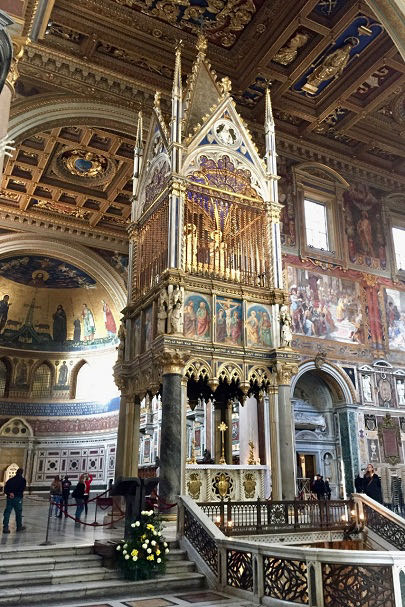 This ornate reliquary in San Giovanni is said to contain the heads of both Saint Peter and Saint Paul
This ornate reliquary in San Giovanni is said to contain the heads of both Saint Peter and Saint PaulAccording to tradition, the heads of St Paul and St Peter are enshrined in the Archbasilica of Saint John in Lateran which is the oldest public church in the city of Rome and one of the other Papal basilicas.
You can visit all the Papal basilicas on a special tour!
What is a Papal Basilica?
The term "Patriarchal Basilica" used to refer to basilicas ceremonially assigned to one of the ancient Patriarchal sees of early Christendom.
Saint Paul Outside the Walls was originally assigned to the patriarch of Alexandria.
In 2006, Pope Benedict declared the term Patriarchal Basilica to be obsolete, and now the four churches of Saint Peter, Saint John Lateran, Saint Paul Outside the Walls, and Saint Mary Major are called Papal Basilicas, or Major Basilicas.
They are set aside from other churches as they have a Papal throne and Papal high altar, and also have a Holy Door, which is opened only during the Papal Jubilee years for pilgrims to pass through.
Is St Paul's tomb in the Vatican?
Because Saint Paul is such an important figure not only in the Catholic church, but in Rome specifically, people often ask if St. Paul is buried in the Vatican.
If, by the Vatican, you are referring to St Peter's Basilica, then no, he is not there.
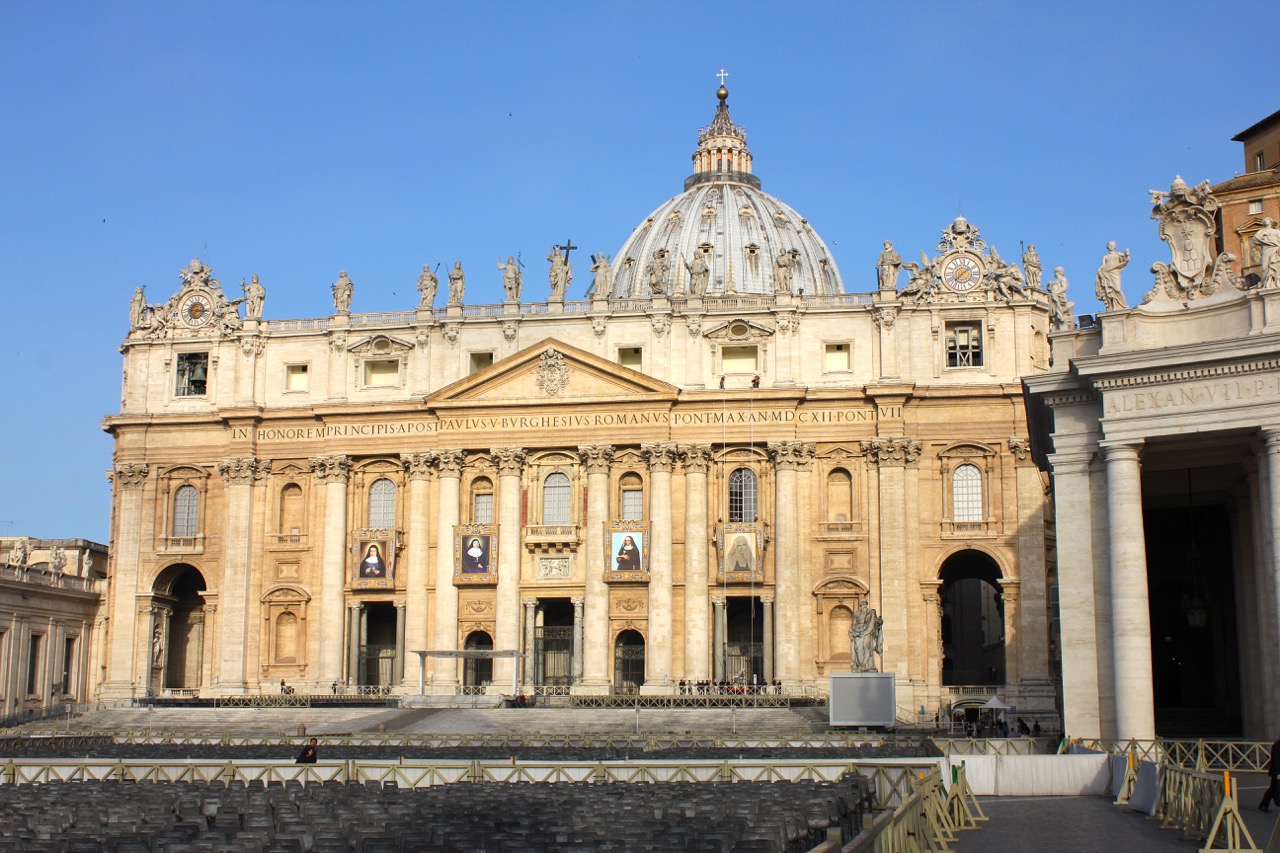 Saint Paul was not buried at St Peter's Basilica - although there is a huge statue of him in the square!
Saint Paul was not buried at St Peter's Basilica - although there is a huge statue of him in the square!However, the Basilica of Saint Paul Outside the Walls is a papal basilica and is Vatican territory.
So technically, his tomb is in the Vatican, just not in Vatican City.
What's the difference between a cathedral and a basilica?
A basilica refers to an architectural shape, such as this church and Saint Peter's Basilica. A cathedral on the other hand, must have a bishop to be called a cathedral.
Of the 4 papal basilicas in Rome, only Saint John in Lateran is a cathedral because it has a bishop. Its bishop is always the current pope.
What is the history of Saint Paul Outside the Walls Basilica?
The history of the Basilica di San Paolo Fuori le Mura began almost immediately after the execution of Paul in Rome.
Saint Paul's body was buried two miles away from the site of his martyrdom in the sepulchral area along the Ostiense Way.
This was owned by a Christian woman named Lucina and soon became a place of veneration known as a cella memoriae.
Emperor Constantine (the first Roman emperor to convert to Christianity) later ordered that a church be built on this site.
This basilica was significantly extended by Theodosius I into what is now known as the Basilica di San Paolo Fuori le Mura.
This explains why the church is so far from the city center of Rome.
Historical sources show that over the centuries, the building was damaged, enlarged and adapted due to attacks and earthquakes.
The Golden Age of San Paolo Fuori le Mura was during the Middle Ages.
This is when the church acquired some of its most beautiful mosaics, the baldaquin, the cloister and the Paschal Candle.
In 1823, the church was sadly ravaged by a fire that destroyed much of the original structure and features.
Thanks to an influx of international donations the entire church was rebuilt, and the whole building was reconsecrated in 1854 in the presence of Pope Pius IX and fifty cardinals.
The perfect 3-day itinerary in Rome
Trying to figure out how to organize your visit to Rome? I've got the perfect 3-day itinerary for first-time visitors (or those who have not been here in a while.) It works for a 2.5 day visit as well.
In my 3-day itinerary, you'll see all the major must-see Rome attractions like the Vatican, Colosseum, Trevi Fountain, Pantheon, Piazza Navona, Spanish Steps, and much more.
And if you have more time, or want suggestions for extra/other things to do, you'll find that there too.
Visit my page with the best 3-day itinerary in Rome for first-timers.
What is there to see in the Basilica of St Paul Outside the Walls Rome?
The interior of San Paolo fuori le Mura is some of the most impressive decoration of any basilica papale.
It is even more impressive given that the majority of the original church was destroyed by a fire in 1823 and what you see today is a restoration.
The front courtyard and facade mosaics
Much of what you see in the Piazzale San Paolo and on the facade of the church is not original, after the fire destroyed huge parts of the walls interior and exterior.
In 1825 Pope Leo XII invited donations for the rebuilding of the basilica, instructing that it replicate the original building, while preserving what could be preserved.
When the building commenced, it was determined that recreating the original would not be possible, so the new church is not an exact copy of the original structure.
Nevertheless, many of the mosaics that date from various periods have been restored over time and are of great religious and artistic interest and value.
The courtyard of Piazzale San Paolo does retain many of the earlier mosaics that give St Paul's Basilica an impressive facade.
On arrival you will be immediately struck by the golden mosaics gleaming in the sun.
The central nave and the portraits of every Pope
The main nave of St Paul's Basilica features 80 columns plus a wonderful ceiling of wood and stucco from the 19th century.
The triumphal arch and a small part of the apse remain of the ancient basilica today.
The new basilica continues the tradition of featuring portraits of all the popes, which was begun in ancient times.
The mosaic versions in place today date from the 19th century and beyond.
Upon the triumphal arch, you will see mosaics that date from the 5th century, but they have been heavily altered following the disastrous fire.
If you're looking for somewhere to stay in Rome that is slightly outside of the busy city center, the neighborhood of Ostiense where you'll find St Paul Outside the Walls is a great option.
Whether you're looking for hotels, apartments or premium accommodation, you're sure to find something to suit you!
The main altar
The main altar is also known as the Papal Altar.
This means that the altar can only be used in celebrations by popes.
It stands upon one of the most holy sites in the central cloister as it is above the tomb of San Paolo.
In 1840, following the rebuilding of the basilica, Pope Gregory XVI consecrated the new Altar of the Confession and the Transept.
The apse's mosaics
The apse of the Basilica of St Paul was once decorated with beautiful mosaics.
Like most of the buildings, these were destroyed in the fire of 1823.
While Pope Leo XII issued instructions that these be replicated as per the originals, only traces of these remain.
These were used in the recreations that you see today.
The magnificent monumental mosaic of the apse was commissioned by Pope Honorius III and is believed to have been created around 1220 BCE.
It depicts Christ with St Peter, St Paul, St Andrew, and St Luke, with a small depiction of Pope Honorius III crouched by Christ's right foot.
No matter what season you visit Rome, here are 4 essential things we recommend never leaving home without:
St Paul's tomb
You can easily visit the apostle's tomb inside the basilica.
It is under the ciborio, or canopy, which stands close to the front of the church, just before the apse.
Descend a double-sided staircase to see the tomb.
You can even see the original tombstone by heading into the cloister and visiting the small museum just off to the back.
Look for the tombstone high up on the wall of the first room.
The tombstone bears the Latin inscription PAULO APOSTOLO MART ("to Paul the apostle and martyr").
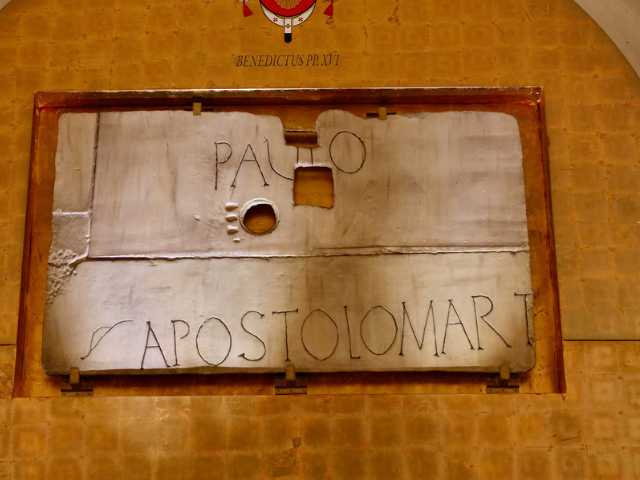 Incredibly, this is the actual tombstone of Saint Paul, which you can see in person when you visit the basilica museum
Incredibly, this is the actual tombstone of Saint Paul, which you can see in person when you visit the basilica museumThe discovery of the sarcophagus was mentioned in chronicles of the Benedictine monks who lived here.
The significance of the tomb and the fact that it was highly likely the resting place of Saint Paul's remains was only suggested by Vatican City archaeologists in 2006, and later confirmed by Pope Benedict XVI in 2009.
The medieval cloister and exhibition area
The medieval cloister of St Paul's Basilica is highly regarded as one of the most beautiful examples from the Middle Ages.
Built between 1205 and 1241 by renowned sculptor Vassalletto, it is notable for its double columns and mosaics.
The latter are golden and colored glass and depict a variety of themes.
The columns are unusual in all being different shapes.
Within the cloister is an exhibition area featuring many interesting artefacts, including, as mentioned above, the original tombstone of Saint Paul.
These artefacts also include remnants of the original basilica rescued after the fire and a fascinating sarcophagus featuring scenes portraying the Apollo myth.
The archaeological area
The archaeological area within St Paul's Basilica includes the remains of a monastery dating from the 5th to the 7th centuries.
Its existence was unknown until it was discovered during recent works.
Also within the site are the remains of a spectacular portico complete with columns.
Historians of the era wrote that this portico connected the ancient basilica with the Aurelian Walls.
There are also many interesting artistic finds from the long history of the Eternal city.
Ready to plan your trip?
Book your train
Planning to travel between cities in Italy and other parts of Europe?
Use Trainline to see all the different options available across the different rail companies.
Find your hotel
Find your perfect place to stay in Rome.
Use Booking.com to choose between hotels, guesthouses, and self-catering apartments in neighborhoods throughout the Eternal City.
Buy your TurboPass
Purchase the convenient Turbopass and visit all of Rome's top attractions including the Colosseum, Pantheon, and Vatican.
With one handy pass, it's all included.
Opening hours, location, how to get there
Opening hours
The basilica is open every day from 7:00 AM - 6:30 PM, except when mass is being celebrated (check the Mass times here.)
There is no entrance fee to go inside and explore the church, but to really get the most out of your visit, I recommend joining a guided tour.
You can either book one that is solely for this basilica, or one that takes you to different holy sites around Rome, depending on your level of interest.
Location and How to get there
St Paul Outside the Walls is in the Ostiense neighborhood and it is very easy to reach from Rome city center, in Piazzale San Paolo, 1.
The simplest way to reach this site is to take Metro Line B, with the church entrance only a few minutes walk from the San Paolo metro station stop.
There are also a number of buses which stop nearby, use Google Maps or the Moovit app to find the best route from where you are to the basilica area.
Romewise's Top Travel Resources
Ready to book your trip to Rome? Take a look at these helpful links to companies we use and trust:
- Keep your travel spending simple with the Wise card, which removes all the worry about exchange rates and high transaction fees all over the world
- Search for and book your perfect accommodation
- Our complete guide to what to pack for Rome
- The number one travel accessory, a multi-point travel adapter and voltage converter
- Browse a huge range of tours in Rome and beyond
- Experience unique tours and special access to Rome's most popular sights
- Protect yourself with comprehensive travel insurance
Within this post there are some affiliate links for products and services. For more details about our affiliate policy click here.
Get your 100% free Rome trip planner now!
Simply sign-up today for our free newsletter and get the Romewise Quick Start guide to Rome:
We are committed to respecting your data. Click for our Privacy Policy.
Comments? Questions? Suggestions?
Please come over to the private Romewise Facebook group and join in the conversation.
You will often find me there, happy to answer your questions / comments!
You will also meet other Rome lovers and experts, too.
What are you waiting for?
- Romewise Home Page
- What to Do in Rome
- saint paul outside the walls


